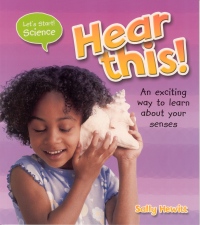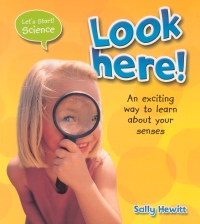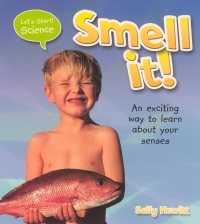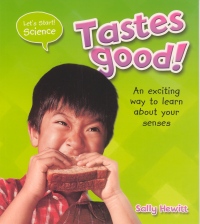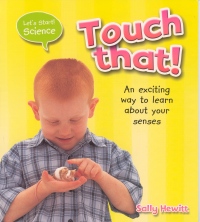| ________________
CM . . .
. Volume XV Number 3. . . .September 26, 2008
excerpt:
Sally Hewitt's five books about the senses, Hear This!, Look Here!, Smell It!, Tastes Good!, and Touch That!, will likely be an addition to many classrooms, schools, and public libraries. While resources for teaching and learning about the senses are not as rare as materials for science topics like the wheel and axle system, soil, and gravity, too often the books that are appropriate for young learners simply tell about the senses and do not include activities that underpin and develop a richer understanding. Hewitt has made certain that her books include a minimum of five explorations and/or investigations. Although uneven in originality and the depth of thinking required, there are several activities that will appeal to children. These include a test to determine how sensitive bare feet are in helping to identify unseen objects, telling a story without saying a word, identifying the location of a smelly cheese by sniffing it out, and investigating to find out how important binocular vision is in determining how far away an object is by placing a cap on a pen held at arm's length with one eye shut. Each book in the "Let's Start! Science" series has been designed to attract the attention of children. Primary and secondary colours were chosen in unique combinations for the covers. Even if a child can't read the blue "Look here!" on the yellow/yellow-ochre background, the photographic illustration of a blue-eyed, blond girl looking through a magnifying lens will let the child know that the book is about the sense of sight, not the sense of taste (a boy biting into a sandwich), the sense of hearing (a girl holding a large conch shell to her ear), the sense of touch (a boy holding a hamster in the palm of his hand with the intention of petting it with his finger) or the sense of smell (a boy with a squinched up face holding what must be a smelly red fish in both hands). The interior of each book is as colourful as the cover. Most pages have a two-toned coloured border and one to three photographic images that represent the printed information provided by Hewitt. Pages with activities are distinguished by a 9-10 cm streak of blue, yellow or pink on which the word "Activity" is printed in a bold black font - a design feature that children, as well as their parents and teachers, will recognize without reading. Hewitt has also included a table of contents, a glossary of six to nine new terms introduced in the text (identifiable by the bold font), and an index,
Recommended with reservations. Barbara McMillan is a professor of early years science education in the Faculty of Education at the University of Manitoba.
To comment
on this title or this review, send mail to cm@umanitoba.ca.
Copyright © the Manitoba Library Association. Reproduction for personal
use is permitted only if this copyright notice is maintained. Any
other reproduction is prohibited without permission.
NEXT REVIEW |
TABLE OF CONTENTS FOR THIS ISSUE
- September 26, 2008.
AUTHORS |
TITLES |
MEDIA REVIEWS |
PROFILES |
BACK ISSUES |
SEARCH |
CMARCHIVE |
HOME |
